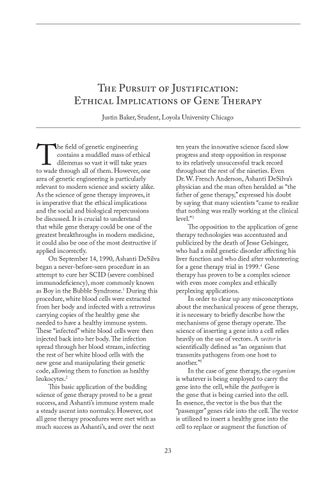The Pursuit of Justification: Ethical Implications of Gene Therapy Justin Baker, Student, Loyola University Chicago
T
he field of genetic engineering contains a muddled mass of ethical dilemmas so vast it will take years to wade through all of them. However, one area of genetic engineering is particularly relevant to modern science and society alike. As the science of gene therapy improves, it is imperative that the ethical implications and the social and biological repercussions be discussed. It is crucial to understand that while gene therapy could be one of the greatest breakthroughs in modern medicine, it could also be one of the most destructive if applied incorrectly. On September 14, 1990, Ashanti DeSilva began a never-before-seen procedure in an attempt to cure her SCID (severe combined immunodeficiency), more commonly known as Boy in the Bubble Syndrome.1 During this procedure, white blood cells were extracted from her body and infected with a retrovirus carrying copies of the healthy gene she needed to have a healthy immune system. These “infected” white blood cells were then injected back into her body. The infection spread through her blood stream, infecting the rest of her white blood cells with the new gene and manipulating their genetic code, allowing them to function as healthy leukocytes.2 This basic application of the budding science of gene therapy proved to be a great success, and Ashanti’s immune system made a steady ascent into normalcy. However, not all gene therapy procedures were met with as much success as Ashanti’s, and over the next
ten years the innovative science faced slow progress and steep opposition in response to its relatively unsuccessful track record throughout the rest of the nineties. Even Dr. W. French Anderson, Ashanti DeSilva’s physician and the man often heralded as “the father of gene therapy,” expressed his doubt by saying that many scientists “came to realize that nothing was really working at the clinical level.”3 The opposition to the application of gene therapy technologies was accentuated and publicized by the death of Jesse Gelsinger, who had a mild genetic disorder affecting his liver function and who died after volunteering for a gene therapy trial in 1999.4 Gene therapy has proven to be a complex science with even more complex and ethically perplexing applications. In order to clear up any misconceptions about the mechanical process of gene therapy, it is necessary to briefly describe how the mechanisms of gene therapy operate. The science of inserting a gene into a cell relies heavily on the use of vectors. A vector is scientifically defined as “an organism that transmits pathogens from one host to another.”5 In the case of gene therapy, the organism is whatever is being employed to carry the gene into the cell, while the pathogen is the gene that is being carried into the cell. In essence, the vector is the bus that the “passenger” genes ride into the cell. The vector is utilized to insert a healthy gene into the cell to replace or augment the function of 23
